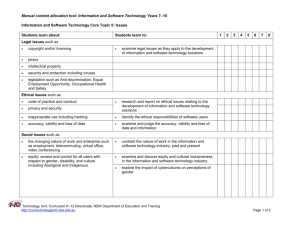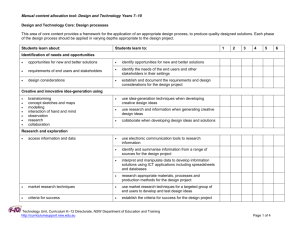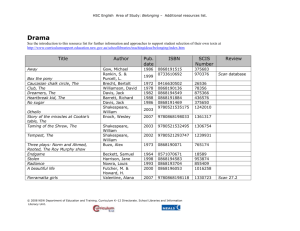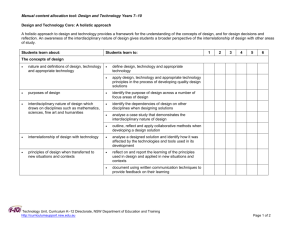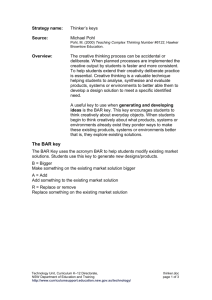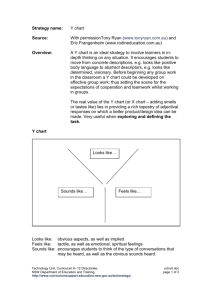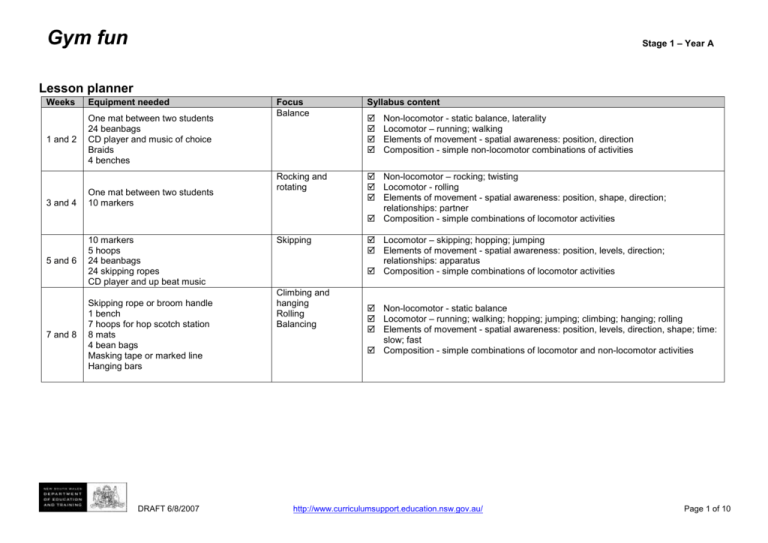
Gym fun
Stage 1 – Year A
Lesson planner
Weeks
Equipment needed
1 and 2
One mat between two students
24 beanbags
CD player and music of choice
Braids
4 benches
3 and 4
One mat between two students
10 markers
5 and 6
10 markers
5 hoops
24 beanbags
24 skipping ropes
CD player and up beat music
7 and 8
Skipping rope or broom handle
1 bench
7 hoops for hop scotch station
8 mats
4 bean bags
Masking tape or marked line
Hanging bars
DRAFT 6/8/2007
Focus
Balance
Syllabus content
Rocking and
rotating
Non-locomotor – rocking; twisting
Locomotor - rolling
Elements of movement - spatial awareness: position, shape, direction;
relationships: partner
Composition - simple combinations of locomotor activities
Skipping
Locomotor – skipping; hopping; jumping
Elements of movement - spatial awareness: position, levels, direction;
relationships: apparatus
Composition - simple combinations of locomotor activities
Climbing and
hanging
Rolling
Balancing
Non-locomotor - static balance, laterality
Locomotor – running; walking
Elements of movement - spatial awareness: position, direction
Composition - simple non-locomotor combinations of activities
Non-locomotor - static balance
Locomotor – running; walking; hopping; jumping; climbing; hanging; rolling
Elements of movement - spatial awareness: position, levels, direction, shape; time:
slow; fast
Composition - simple combinations of locomotor and non-locomotor activities
http://www.curriculumsupport.education.nsw.gov.au/
Page 1 of 10
Outcomes
Learning experience
GYS1.10 Follows a simple sequence
that links basic movement patterns
takes weight on different
parts of the body using
small and large bases of
support
performs known patterns
with different movement
qualities
Weeks 1 and 2
Getting started
Play a game of Freeze Frames.
Students travel in a particular direction using a particular locomotor movement assigned by
the teacher. Students can move to music or just listen for the teacher’s command. When the
music stops or the teacher commands to do so, students are required to create a statue of
the character which is called out by the teacher. Characters may include: Superman, tennis
player, ballerina, lion, snake, monster etc. Students are required to hold the position for three
seconds without moving. On the teacher’s command or when the music starts, students begin
to move around the room again.
GSS1.8 Performs fundamental
movement skills with equipment in
minor games
participates in a range of
minor games and practices
that assist skill
development
MOS1.4 Demonstrates maturing
performance of basic movement and
compositional skills in a variety of
predictable situations
balances on different body
parts
INS1.3 Develops positive
relationships with peers and other
people
displays cooperation in
group activities
listens and responds to
others
uses positive talk to
encourage others
observes rules regarding
group conduct
Teaching notes and planned
assessment
The getting started activity is sufficient in
preparing students in Stage 1 to be warmed up
ready for the lesson. It should involve ‘huff and
puff’ activities (activities which raise the heart
rate). Specific stretching is not necessary.
The locomotor movements in the warm up may
include: skipping, running, hopping and
jumping.
Developmental activities for balance
Discuss the term balance. Ask students questions like:
- what does balance mean?
- how do you balance your body?
- in what situations do you need to balance your body?
- why is it important to learn how to balance?
Balance is an essential prerequisite of almost
all movement skills. The ability to perform a
stationary balance for a specific period of time
has been linked to a reduced risk of suffering
from falls.
Spread mats out in the designated area for the lesson. Allow one mat for every two students.
In pairs, ask students to position themselves on their mats. Students listen to the instructions
and demonstrate each balance on different body parts.
- bottom and one hand
- two feet and two hands
- two elbows and two knees.
Practise the following partner balances.
- Standing back to back, with knees bent as if sitting on a chair.
- Feet together, toes to toes, facing each other hold hands and lean back so arms are
straight.
- Stand side on, sides of feet together, holding just one hand, extend arms straight
and lean out to the side.
Ask each pair to create their own partner balance.
Encourage students to hold balances for three
to five seconds.
Ask students to stand with a beanbag on their head. Lift one foot off the floor without dropping
the beanbag. Change feet. Challenge students to do the following without dropping the
beanbag:
- lift one leg out to the side
- lift knee up to chest
- pick an object up off the floor
- walk and move at different speeds and directions.
Partner (counter) balances work better and are
safer if students have been paired in similar
heights/sizes.
This activity requires students to coordinate
movement and body control, a principal
essential to most gymnastic skills.
Ask questions like:
© State of New South Wales through the NSW Department of Education and Training, 2007. All rights reserved. Not part of NEALS
Physical education – Gymnastics S1
DRAFT 6/8/2007
http://www.curriculumsupport.education.nsw.gov.au/
Pa
Outcomes
Learning experience
-
Teaching notes and planned
assessment
which action was the easiest/hardest?
what helps you keep your balance?
Revise the components of the static balance. Give
students an opportunity to explore the skill before
showing them how. When demonstrating and teaching
the balance use the following cues:
1. Stand still with your foot flat on the ground.
2. Hold your bent leg away from your other leg.
3. Look at something in front of you.
4. Stand up tall when you balance.
5. Relax your arms.
Refer to Get skilled: Get active page 18-19 for
further information.
Ask students to perform a static balance, swapping legs so they experience balancing on
both legs.
Balance team activities
The following activities allow students to explore the components of balance on the floor as
well as using simple equipment.
Divide students into four teams. Students may like to nominate a name for their team.
All teams complete the following activities as a whole class at the same time:
Bean bag balance
Teams line up at one end of their own bench or balance beam. One student at a time walks
along the bench balancing a bean bag on their head. If the bean bag falls, students need to
start again. Once one student has made it to the other end, the next student may start. When
the whole team is finished they should be sitting down in a straight line in front of their bench.
Simon says
Each team steps up onto their bench and is asked to stand very still. The teacher is ‘Simon’
and calls out balance commands for a game of Simon says. The aim is to get to the end of
the activity without having any team mates over balancing off the bench.
Static balance relay
Each team spreads out in a straight line on the floor, standing one behind the other, about
one metre apart. Team members perform the static balance. The first student removes
themselves from the line and on the teacher’s command weaves their way in and out of their
fellow team mates. If anyone on their team loses their balance then the runner has to start
again. Once the runner has made it to the end they resume the static balance position and
the new person at the start of the line becomes the runner. Repeat the activity until all team
mates have had a go of weaving through their team.
© State of New South Wales through the NSW Department of Education and Training, 2007. All rights reserved. Not part of NEALS
Physical education – Gymnastics S1
DRAFT 6/8/2007
Students should step off the bench once
reaching the end to prevent inappropriate
jumps and dangerous landings.
If the benches used do not fit an entire team
standing safely along them, you may have to
divide each team into two and have half on the
bench and half on the floor. Swap over half way
through the activity.
Assessment strategy
The teacher:
observes students’ ability to
observe rules and cooperate in
groups
observes students’ ability to
balance individually and with
apparatus
Assessment criteria
The student:
listens and responds to others
http://www.curriculumsupport.education.nsw.gov.au/
Pa
Outcomes
Learning experience
Teaching notes and planned
assessment
Finishing off
Play the game Magic balance.
Choose three students to be taggers and one to be the magician. Students move randomly in
a designated area to music. When students are tagged, they have to perform and remain in a
static balance until the magician releases them. The magician uses a braid to wave over the
tagged student to release them.
uses positive talk to encourage
others
takes weight on different parts of
the body using a small base of
support
maintains stability of upper body
when stationary on a small base
of support
maintains control of upper body
whilst balancing an apparatus
These criteria relate to outcomes
GYS1.10 and INS1.3
Where possible, the finishing off activity should
revise the skills learnt in the lesson. This is not
possible in all lessons because it is important
for lessons to involve sufficient elements of
vigorous activity so heart rate is sufficiently
raised.
Therefore, finishing off activities (like this
lesson) need to raise the students heart rate
(incorporate ‘huff and puff’ activity) if it was not
sustained through the lesson.
GYS1.10 Follows a simple sequence
that links basic movement patterns
takes weight on different
parts of the body
transfers weight using a
variety of body shapes and
positions
draws on imagination to
select movement patterns
MOS1.4 Demonstrates maturing
performance of basic movement and
compositional skills in a variety of
predictable situations
balances on different body
parts
repeats movements to form
a sequence
INS1.3 Develops positive
relationships with peers and other
people
displays cooperation in
group activities
Weeks 3 and 4
Getting started
Play the game Chain tag.
Two students chase the rest of the group in the designated space. When a student is
tagged they join hands to form a chain. When there are more than five people on the
chain, they can break the link to start a new chain. Only the leader and end student can
tag.
Developing rocking techniques
Ask students to form pairs on mats. Explain to students that rocking assists us in moving
and exploring the space around us. Each rocking activity will be performed as a whole
class.
It is important to explicitly demonstrate each rocking action prior to asking students to
complete it.
Rocking is a skill that helps develop a student’s
sense of body control and spatial awareness. It
is an important component of a number of
different gymnastics rotations.
Rock the boat
Instructions:
- lie on your back
- hug your knees into chest (this is like the tuck position)
- grab your legs to hold your body in tight
- rock backwards and forwards and side to side like a boat rocking on waves.
© State of New South Wales through the NSW Department of Education and Training, 2007. All rights reserved. Not part of NEALS
Physical education – Gymnastics S1
DRAFT 6/8/2007
http://www.curriculumsupport.education.nsw.gov.au/
Pa
Outcomes
listens and responds to
others
uses positive talk to
encourage others
observes rules regarding
group conduct
Learning experience
Teaching notes and planned
assessment
As a challenge, ask students to freeze and balance on their bottom. Feet should be off
the ground and chin should remain tucked into the chest.
Pendulum swing
- sitting up on your bottom, hug your knees tightly into your chest
- rock right back onto your back
- gradually rock faster and bigger to get back onto your bottom without letting go of
your legs.
Can you stand?
- hug your knees into chest (this is like the tuck position)
- rock back and forth
- On the third rocking action forward, try to roll up onto your feet in a crouched
position without your hands touching the floor.
Rocking challenge
- link arms with your partner
- rock on your backs and try and get up at the same time without using arms to
balance or to assist when standing up.
Stations are a good way of incorporating
various skills learnt in lessons in small group
situations. Students should spend between 2-3
minutes at each station.
Stations which explore different rotations
Divide students into four groups and have them rotate around the following stations.
Station 1 - Twists
On a mat, students perform a straight jump with a ¼ turn (a turn to the left or right).
Students who can master a balanced landing for this can try a ½ turn and then a full turn.
Station 2 - Rocking
Students position themselves in a tuck position on the mat, rock three times and attempt
to stand without having to use hands to push off. (This is the same as the Can you stand?
activity above)
Station 3 - Double up
In pairs, students lie head to head and perform log rolls while connecting hands to create
a long log. Ask students to count how many times they can roll.
Station 4 - Around the world
Students sit on the mat, bring knees up to chest and hold onto their ankles. Students try
and rotate in a circle by shuffling sideways on their bottom.
Station 5 - Splattered egg
© State of New South Wales through the NSW Department of Education and Training, 2007. All rights reserved. Not part of NEALS
Physical education – Gymnastics S1
DRAFT 6/8/2007
http://www.curriculumsupport.education.nsw.gov.au/
Pa
Outcomes
Learning experience
Teaching notes and planned
assessment
One student from each group stands as the leader. The rest of the group positions
themselves in the egg roll starting position. The leader calls either left or right and the
group have to roll in that direction. A student who rolls the wrong way or takes too long is
out and swaps places with the leader.
Finishing off
Play the game Imagination
Call out an imaginary situation that involves a locomotor movement.
- run like you are the police chasing a criminal
- walk like you are lost
- walk like you are barefoot on hot gravel
- walk like you are trudging through mud
- walk like you are skating on ice
- walk like you are carrying a heavy load.
GYS1.10 Follows a simple sequence
that links basic movement patterns
performs simple movement
sequences
GSS1.8 Performs fundamental
movement skills with equipment in
minor games
participates in a range of
minor games and practices
that assist in skill
development
MOS1.4 Demonstrates maturing
performance of basic movement and
compositional skills in a variety of
predictable situations
repeats movements to form
a sequence
Weeks 5 and 6
Getting started
Play the game Steal the beanbag.
Each student has one beanbag that they place between their knees. On the teacher’s
signal, students are to try and steal other people’s beanbags. The only way to protect
your beanbag is to jump out of the way. You cannot protect your own beanbag with your
hands.
Developing the skip
Teaching and exploring the skip.
Play some upbeat music, asking students to skip around in a circle. This is a good
opportunity to observe student’s skill level.
Change direction of the circle and ask students to try and skip so that their arms are
moving with their legs rather than in opposition.
When stopped, ask students to explain which was the best way to use their arms when
skipping (arms swing in opposition to the legs).
Skipping is a rhythmical locomotor skill that is
basic to many children’s games. It is also
fundamental to good footwork in numerous
sports such as basketball, netball and touch
football, and many forms of dance.
The skip should be taught as a rhythmical
movement, with the focus on developing the
step hop-rhythm, rather than performing the
movement with speed.
Assessment strategy
The teacher:
observes students performing a
skipping sequence
Demonstrate, or ask a student to demonstrate the skip. In a given space, play some music
and ask students to skip until the music stops. Use the following cues to assist in explicitly
© State of New South Wales through the NSW Department of Education and Training, 2007. All rights reserved. Not part of NEALS
Physical education – Gymnastics S1
DRAFT 6/8/2007
Assessment criteria
The student:
http://www.curriculumsupport.education.nsw.gov.au/
Pa
Outcomes
Learning experience
Teaching notes and planned
assessment
teaching the skip:
- use light springing steps
- keep eyes straight ahead
- provide a simple rhythm for the students to follow e.g. step, hop, step, hop
- take off and land on the front of your foot
- make sure your body faces to the front.
Ask students to stand in the middle of the room or space. Call out a direction and have
students skip to that area.
coordinates movements of body
parts
executes correct technique for
the skip (see teaching points)
repeats skipping movements to
fluently form a sequence
These criteria relate to outcomes MOS1.4
and GYS1.10
Skipping with ropes
Each student requires a skipping rope and needs to be in their own space. Ask students
to perform the following tasks with their ropes.
1. Swing the rope backwards and forwards under the feet as if it was a pendulum. They
jump over the rope as it goes forwards and backwards.
2. The rope is rotated in a full circle (over the head) and students attempt to make five
continuous jumps.
3. Students continue with the full circle rotations and attempt the following types of
jumps: side to side jumps, hopping over the rope, running, jumping backwards.
Students who struggle to jump the rope when it
rotates in the complete circle can attempt the
same activity using the pendulum swing rope
action.
4. Skip and wrap. Student attempt to perform five continuous skips and after the fifth
skip, stop the rope by trapping it under the foot.
This trapping technique is a neat way to
complete a sequence of skipping and is used in
rhythmic gymnastics.
5. Hoop Relay. Students are divided into five teams and line up behind their own
marker. The first person in each team, skips using a hoop down to their opposite
marker and returns to give the hoop to the next team mate before making their way to
the back of the line. The first team to have all members complete the course are the
winners.
Finishing off
Play the game Rob the nest.
Divide the class into four groups. Place all of the beanbags in a hoop in the middle of the
playing space. Organise teams to be equal distance from the middle hoop. On the
teacher’s signal, students have to skip into the middle and steal a bean bag and take it
back to their ‘nest’. Only one person from each team can move away from their nest at a
time. Once all beanbags have been taken from the middle hoop, students can start
robbing beanbags from other teams’ ‘nests’. The teacher signals for the game to stop so
beanbags can be counted.
© State of New South Wales through the NSW Department of Education and Training, 2007. All rights reserved. Not part of NEALS
Physical education – Gymnastics S1
DRAFT 6/8/2007
Allow students to explore for themselves the
most effective method of skipping through a
hoop.
The locomotor action for this activity is
skipping, to practise the skill explicitly taught
earlier in the lesson. Other locomotor
movements can be used.
http://www.curriculumsupport.education.nsw.gov.au/
Pa
Outcomes
Learning experience
GYS1.10 Follows a simple sequence
that links basic movement patterns
takes weight on different
body parts of the body,
using small and large bases
of support
performs known patterns
with different movement
qualities
explores ways of travelling
along benches
performs simple movement
sequences
draws on imagination to
select movement patterns
Weeks 7 and 8
Getting started
Play the game Pirate Ship.
Designate areas of the ship in the playing area e.g. front, back, left side, right side. As
each ship signal is called, students move quickly to that part of the ship. When an
instruction is called, students perform it as quickly as they can and until the next
instruction is called. Instructions include:
- Climb the ladder - students move arms and legs as if climbing a ladder
- Scrub the deck - students crouch down and pretend to scrub the floor
- Person over board - lay on the floor and pretend to swim
- Captain’s coming - stand up straight and salute.
GSS1.8 Performs fundamental
movement skills with equipment in
minor games.
participates in a range if
minor games and practices
that assist in skill
development
MOS1.4 Demonstrates maturing
performance of basic movement and
compositional skills in a variety of
predictable situations
repeats movements to form
a sequence
balances on different body
parts
absorbs force when
jumping and landing from
different heights
Teaching notes and planned
assessment
Gymnastics circuit
This activity provides the opportunity for schools with adequate equipment to introduce basic
climbing and hanging skills at a station that is part of a circuit of seven activities. Schools
without adequate equipment can use the alternative activity for station 1. This circuit allows
students to revise and practise skills learnt in previous activities. These activities can be
reinforced over two sessions.
This activity requires seven different stations to be set up. Each station must be explained
with either the teacher or a student demonstrating the skill. Ensure key teaching points are
emphasised.
Students move around the stations in groups of four and spend three minutes at each station.
Ensure students know which direction they are moving in. Clearly numbered stations may
help.
Station 1 - Climbing and hanging
Use a skipping rope or broom handle to demonstrate how to perform an over-hand grip on
the bars. This involves the palm of the hand being placed over the bar and the thumb
underneath. Fingers should initially be pointing away from the student and then should
wrap around bar and be pointing towards student. If a bar is available, give students the
opportunity to practise basic hanging movements on the bar. This involves keeping arms
straight and hanging.
Give students the opportunity to make a ‘v’ with their legs, or a small leg tuck (students
curl their legs up to their chest). Do not let students lean/drop their head back as this
places pressure on the neck.
Emphasise the use of a motorbike landing when returning to the ground. Set the bar at a
height where the majority of students can easily reach it.
Alternative activity: If a bar is unavailable ask students to perform a series of three
different jumps, making different shapes with their body.
© State of New South Wales through the NSW Department of Education and Training, 2007. All rights reserved. Not part of NEALS
Physical education – Gymnastics S1
DRAFT 6/8/2007
Climbing and hanging activities can only be
performed if schools have appropriate and safe
equipment. Outside playing equipment is
adequate for this activity.
Set up the stations in a large circle (space
permitting). This enables the teacher to position
themselves outside the perimeter so that all
stations can easily be seen and students can
easily move from one station to another. The
teacher should primarily position themselves at
the most difficult station.
Assessment strategy
The teacher:
observes students’ movement
patterns and skill execution at
various stations in the
gymnastics circuit
Assessment criteria
The student:
confidently performs known nonlocomotor and locomotor
movements and sequences
creates imaginative ways of
moving
These criteria relate to outcome GYS1.10
Ensure students are only using the straight arm
or bent arm hanging position. Do not allow
students to perform any hang/swing in which
the bar is not grasped with the hands e.g. hock
http://www.curriculumsupport.education.nsw.gov.au/
Pa
Outcomes
Learning experience
Teaching notes and planned
assessment
Station 2 - Egg roll
With two mats joined together, one student at a time performs as many egg rolls as they
can along the mats. Emphasise a tight body, chin tucked into chest, hands pull knees into
chest, roll entire body in one action.
swing (legs hang over the bar and head is
towards the ground)
Station 3 - Hop scotch jumping
Set a short course of single and double hoops. Students are to make their way from one
end of the hoops to the other by hopping and jumping into the hoops. Students hop on
one leg into the single hoops and jump into the hoops where there are two side by side
(so there is one foot in each hoop). Students try to make it to the other end without
touching the sides of the hoop.
This activity allows students to practise two
locomotor movements alternatively.
Station 4 - Log roll
With two mats joined together, one student at a time performs as many log rolls as they
can along the mats. Emphasise a tight body, ankles together, arms stretched tight above
the body, roll the entire body in one action.
This activity allows students to practise body
control which is required for the static balance.
Station 5 - Balance off
All group members perform a static balance on one leg on the
mats. A competition is held of who can balance the longest. For
students who find this too easy, shrink the base of support so
that they have to balance on the ball of their feet.
Station 6 – Movement sequences and straight jump off small bench
Students explore ways of travelling from one end of a bench to the other.
Students then perform a straight jump from a small bench or step and perform
a motorbike landing.
Emphasise the importance of landing with bent knees with feet shoulder width
apart. Ask students to count how many times they can stick their landing.
Station 7 - Walk the plank
Students walk along a line e.g. court marking or masking tape, while balancing a bean
bag on their head. Ask students to count how many times they can make it to the other
end without the bean bag falling off.
Ensure the students are jumping from a low
bench. Some students may feel more confident
performing the straight jump from the floor.
Have students jump one at a time from the
bench. Encourage students to jump for height
rather than distance.
This task requires students to practise a
number of key components for the balance
including a tall posture and a stable head and
trunk.
Finishing off
Play the game Team follow the leader.
In small groups, ask students to line up behind their leader. The leader moves around the
space demonstrating a particular locomotor movement. When the teacher calls ‘change’,
the leader runs to the end of the line and the new leader demonstrates new actions. This
activity could involve the students playing team follow the leader on the equipment.
© State of New South Wales through the NSW Department of Education and Training, 2007. All rights reserved. Not part of NEALS
Physical education – Gymnastics S1
DRAFT 6/8/2007
http://www.curriculumsupport.education.nsw.gov.au/
Pa
© State of New South Wales through the NSW Department of Education and Training, 2007. All rights reserved. Not part of NEALS
Physical education – Gymnastics S1
DRAFT 6/8/2007
http://www.curriculumsupport.education.nsw.gov.au/
Pa

